This album was created by a member of the TPS Teachers Network, a professional social media network for educators, funded by a grant from the Library of Congress. For more information, visit tpsteachersnetwork.org.
5 Super Cool Primary Sources I've seen this week that could be QFocus Prompts
Album Description
 QFT
QFT  QFocus
QFocus  NCSS19
NCSS19  NCTE19
NCTE19  bestof
bestof
I spent some time at the NCTE and NCSS national conferences this week. Here are a few of the super cool primary sources I saw this week that made me absolutely BURN to try the QFT with them. Here are some of my musings and questions I'd ask about them. How do you see using them? How might they relate to content that you teach?
Wi-jun-jon, Pigeon's Egg Head (the Light) Going to and Returning From Washington, 1837-1839
Teaching Notes
This is so cool! I think it is a primary source?
I'd be asking:
What is the message? Is this meant to be a satire of assimilation? Is this a successful or unsuccessful assimilation and in who's eyes?
Who was the artist?
Why does the man on the right have a fan and an umbrella? Is this meant to suggest that he isn't quite "doing" Western dress properly? What similarities does this have with Jim Crow caricatures?
What is the emotion on his face on each setting? Are we meant to read him as smug on the right hand side?
"I Ask Only for Your Help, and God's" 1963
Teaching Notes
A card that shows President Lyndon Johnson's handwritten edits to the short speech he gave on November 22, 1963, following the assassination of President John F. Kennedy. Fascinating edit from "the nation suffers a loss that cannot be weighed" to "we have suffered a loss that cannot be weighed." Why did he make that change? What's the effect? The English teacher in me is dreaming up a lesson on oratory skills or persuasive writing.
This site also has audio of a call from President Johnson to Jackie Kennedy and a youtube video of a curator in the exhibit hall at the LBJ Library.
[African American children on way to PS204, 82nd Street and 15th Avenue, pass mothers protesting the busing of children to achieve integration]
Teaching Notes
Thank you Cheryl Lederle for bringing this image to NCTE! My partner and I were asking:
- Why don't the children have any umbrellas?
- Where are the mothers of these children? Why are they so totally outnumbered?
- What is the emotion on the faces of the adults? Are they self-conscious? Ashamed? Did they know that they were in a photograph?
A powerful image...how would you use it in the classroom? To introduce a civil rights unit? School integration? I'm reminded of a book I taught, All Souls by Michael Patrick MacDonald, which included a description of the (still) fraught history of school busing in Boston. I'm also curious if there is something present day that this might be paired with?
Reference link: http://www.loc.gov/item/2004670162/
Reference note
Contributor Names: DeMarsico, Dick, photographer
Created / Published: 1965 September 13.
Subject Headings: - African Americans--Education--New York (State)--New York--1960-1970
- Busing (School integration)--New York (State)--New York--1960-1970
- School children--New York (State)--New York--1960-1970
- Public schools--New York (State)--New York--1960-1970
- Women--Political activity--New York (State)--New York--1960-1970
- Demonstrations--New York (State)--New York--1960-1970
Notes: - Title devised by Library staff.
- NYWT&S staff photograph.
- Caption handwritten on verso.
- Date stamped on verso: Sep 13 1965.
- Forms part of: New York World-Telegram and the Sun Newspaper Photograph Collection (Library of Congress).
Repository: Library of Congress Prints and Photographs Division Washington, D.C. 20540 USA
Digital Id: cph 3c34434 //hdl.loc.gov/loc.pnp/cph.3c34434
Colton's map of Boston and adjacent cities.
Teaching Notes
Thanks to some fabulous TPS consortium members, I learned about Sanborn maps for the first time--so cool! A quick search there led me to this map of Boston. Take a close look at the green patch in South Boston; in 1856, 2 blocks from my house, there was a "house of corrections" and "lunatic asylum." Today, this piece of land is a beautiful park and baseball fields that stretch for several blocks. I have so many questions--really? why there? how did it get turned into a park? how did people in the community view these institutions?
This got me thinking about how local maps might be used to get kids curious about all host of issues and topics in their community--city planning, gentrification, urban renewal, stigma around mental health, perhaps even climate change and flood insurance for houses along the water.
Reference note
Contributor Names: J.H. Colton & Co.
Fillmore, Millard, 1800-1874, collector.
Created / Published: New York : Published by J.H. Colton & Co., 1856.
Subject Headings: - Boston (Mass.)--Maps
- United States--Massachusetts--Boston
Genre: Maps
Notes: - Available also through the Library of Congress Web site as a raster image.
Repository: Library of Congress Geography and Map Division Washington, D.C. 20540-4650 USA dcu
Digital Id: http://hdl.loc.gov/loc.gmd/g3764b.fi000070
WWII Superman Comics
Teaching Notes
The Smithsonian has an interesting collection of Superman comic book covers from the 1930's and 40's that show how Superman was deployed as propaganda in support of US involvement in WWII. I think it would be interesting to show students a series of Superman covers over time as an entry point into analyzing cultural values and mores.

